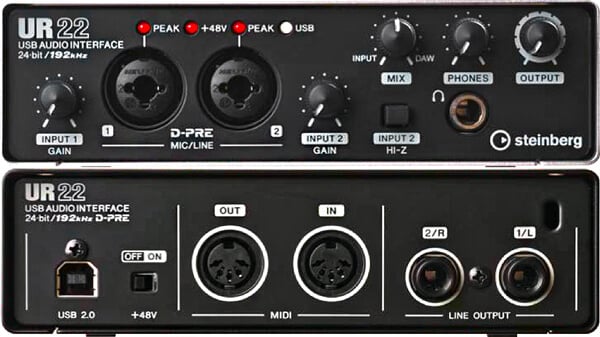Steinberg UR22 USB Audio Interface Review
PROS: Super-portable, rugged enclosure, lightweight, affordable, easy to use.
CONS: None.
PRICE: $149
Tracking with the Steinberg UR22 is a snap and since it’s a 24-bit/192kHz interface, audio quality (assuming your rig can handle it) is pretty darn great for a unit so affordable. We popped it in front of simple DAW programs like GarageBand, as well as more pro-studio setups like Cubase and Mixcraft 7. Setup was simple: plug it into your USB port after installing the drivers (no additional power cable necessary) and then choose which input you want to arm your track with. We really dug the Hi-Z option on Input 2 (don’t forget to engage it on the front panel) for easy tracking of direct, dry guitar and bass signals (we then let our imaginations run wild after we captured raw tracks, by running through a ton of amp simulators and fx).
Controls are simple and intuitive, and for project studios running a few mics, a direct line for guitars/basses, and maybe a MIDI controller for soft synths, it’s a perfect solution. But what we dug more was its ability to be a real road warrior. The rugged, all-metal enclosure means you can toss it in a backpack and take it out on tour. And since it’s powered by USB, all you need is a battery-powered laptop or tablet and you’ve got a mobile recording/practice studio right in your tour van. Perfect for on-the-go demos and scratch tracks, and we didn’t encounter any notable latency (which can an issue for units in this price range).

Got an expensive condenser mic? Well, we tested those out, as well. And that’s where most inexpensive interfaces fall apart. But, most surprisingly, the UR22 is quite capable when it comes to vocals. You’ve got a handy switch for +48v phantom power, and the on-board D-PRE mic preamps from Yamaha are surprisingly good. No, seriously. Surprisingly good. We kept having to check the price to make sure it was right. Vocals were clean and crisp, and while you’re not gonna mistake your new little friend for a Neve console any time soon, you’re gonna be pretty happy with the results.
There’s really nothing negative to say about this particular interface. It’s rugged, it’s hella easy to use, it’s versatile and it’s perfect for mobile and studio applications. At $149, it’s basically ridiculously priced. It even comes with a version of Cubase if you don’t have a DAW already. How cool is that?
FEATURES
MIC INPUT 1/2 (Balanced):
– Frequency Response: +0.1/-0.3dB, 20Hz to 20kHz
– Dynamic Range: 95dB, A-Weighted
– THD+N: 0.008%, 1kHz, -1dBFS, 20Hz/20kHz BPF
– Maximum Input Level: -10dBu
– Input Impedance: 4k Ohm
– GAIN Range: +16dB – +60dB
LINE INPUT 1/2 (Balanced):
– Maximum Input Level: +16dBu
– Input Impedance: 20k Ohm
– GAIN Range: -10dB – +34dB
HI-Z INPUT 2 (Unbalanced):
– Maximum Input Level: -4dBV
– Input Impedance: 470k Ohm
– GAIN Range: +8dB – +52dB
LINE OUTPUT 1/L 2/R (Impedance Balanced):
– Frequency Response: +0.1/-0.6dB, 20Hz to 20kHz
– Dynamic Range: 101dB, A-Weighted
– THD+N: 0.006%, 1kHz, -1dBFS, 20Hz/20kHz BPF
– Maximum Output Level: +10dBU
– Output Impedance: 150 Ohm
PHONES:
– Maximum Output Level: 6mW+6mW, 40 Ohm
